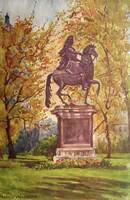Less cheerful has been the fate of Golden Square, which has a forsaken look, and the days when it may have justified its name are past. Originally Gelding Square, from the name of an inn hard by, the grander-sounding and more attractive corruption supplanted the older name. Another derivation for the word is also given-"Golding," from the name of the first builder; but anyhow it was called Golden Square soon after it came into being. The houses round it were built about the opening years of the eighteenth century, when the dismal memories of the Plague were growing faint. For the site of Golden Square, "far from the haunts of men," was one of the spots where, during the Plague, thousands of dead were cast, by scores every night. These gloomy scenes forgotten, the Square was built, and at one time fashionable Lord Bolingbroke lived here, while Secretary for War. It is still "not exactly in anybody's way, to or from anywhere." The garden is neat, with a row of trees round the Square enclosure, and a path following the same lines. In the centre stands a statue of George II., looking thoroughly out of place, like a dilapidated Roman emperor. It was bought from Canons, the Duke of Chandos's house, near Edgware, when the house was pulled down and everything sold in 1747. There are a few seats, but they are rarely used, and it has a very quiet and dreary aspect when compared with the cheerful crowds enjoying the gardens in its larger neighbour, Leicester Square. This was known as Leicester Fields, and was traversed by two rows of elm trees; and even after the houses round it were begun, about 1635, the name of Fields clung to it. The ground was part of the Lammas Lands belonging to the parish of St. Martin's-in-the-Fields, and Robert Sydney, Earl of Leicester, who built the house from which the Square takes its name, paid compensation for the land, to the poor of the parish �3 yearly. The house occupied the north-east corner of the Square, and in after years became famous as a royal residence. It has been called "the pouting-place" of princes, as it was to Leicester House that the Prince of Wales retired when he quarrelled with his father, George I.; and there Caroline the Illustrious gathered all the dissatisfied courtiers, and such wit and beauty as could be found, round her. When he became George II., and quarrelled in his turn with his son, Frederick, Prince of Wales, the latter came to live in Leicester House. The statue of George I. which stood in the centre of the garden was, it was said, put up by Frederick, with the express purpose of annoying his father. A view of the Square in 1700, shows a neatly-kept square garden with four straight walks, and trees at even distances, and Leicester House standing back, with a fore-court and large entrance gates, and a garden of its own with lawns and statues at the back. Savile House, next door to Leicester House, on the site of the present Empire Theatre, was also the scene of many interesting incidents, until it was practically destroyed during the Gordon Riots. The list of great names connected with the Square is too long to recite, but four of the greatest are commemorated by the four busts in the modern garden - Sir Joshua Reynolds, Hogarth, John Hunter, the eminent surgeon, and Sir Isaac Newton. But before these monuments were erected Leicester Square Garden had gone through a period of decay. It was left unkept up and uncared for; the gilt statue was tumbling to pieces, and was only propped up with wooden posts. The garden from 1851 for ten years, was used to exhibit the Great Globe of Wylde, the geographer, who leased the space from the Tulk family, then the owners of the land. Leicester House, after it ceased to be a royal residence, was in the hands of Sir Ashton Lever, who turned it into a museum, which was open from 1771 to 1784, but failed to obtain much popularity. The collection was dispersed, and soon after the house was pulled down and the site built over, and the Square was allowed to get more and more untidy. Several efforts were made to purchase it for the public, but the price asked was prohibitive, as the owners wished to build on it. When, however, after much litigation, the Court of Appeal decided it could not be built on, but must be maintained as an open space, they were more ready to come to terms. A generous purchaser came forward, Mr. Albert (afterwards Baron) Grant, who bought the land, laid it out as a garden, and presented it to the public, to be kept up by the Metropolitan Board of Works. The plans for the newly-restored garden, were made for Mr. Grant by Mr. James Knowles, and the planting done by Mr. John Gibson, who was then occupied with the subtropical garden in Battersea Park. The statue of Shakespeare in the centre, and the four busts, were also the gift of the same public benefactor, who presented the Square complete, with trees, statues railings, and seats, in 1874.

